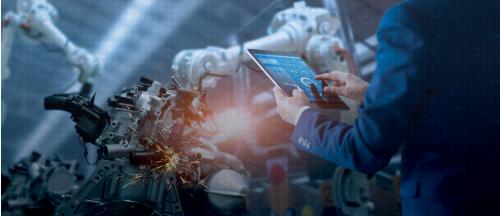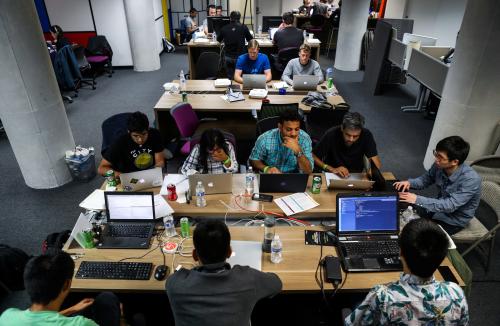One takeaway of our new analysis of automation’s impacts is that the trends might not be that much more disruptive in the next few decades than they were in the last few.
Technological possibility doesn’t mean reality, after all.
In fact, our analysis of the past three decades shows the ratio of jobs to workers actually increased in the years 1980 to 2016—the era that we call IT-driven automation.
What’s more, our main forward-looking forward analysis, employing detailed occupational forecasts provided by McKinsey Global Institute, suggests that only about one quarter of today’s jobs stand to be heavily disrupted by currently available automation and artificial intelligence (AI) technologies in the coming decades.
So that’s good, right? The future may resemble the past; in a way that’s grounds for reassurance—no?
The answer here is, well, ”sort of.” To be sure, the first era of digital automation, from 1980 to 2016, saw the economy create 54 million net new jobs by our count—hardly the end of work. But, our research—which pairs backward-looking with forward-looking analysis—suggests that a future that resembles the recent past will hardly be serene.
Informed by data and procedures derived from those of MIT economist David Autor, our backward-looking research suggests that the first era of digital automation was, in fact, one of traumatic change, defined especially by the “hollowing out” of the labor market, with employment and wage gains coming only at the high and low ends of the skill distribution.

Our research confirms that the expansion of IT-powered automation in the decades after 1980 helped displace millions of “routine” middle-skill jobs, forcing large shifts of workers into low-wage service employment as robots and computers substituted for factory and clerical work. In short, the first wave of digital automation very likely contributed to the decline of the middle class, the explosion of inequality, and perhaps even the 2016 election backlash. To that extent, a future that portends more of the same seems as much cause for disquiet as reassurance.
As to our forward-looking analysis, the projections we’ve done based on occupational forecasts from McKinsey license both optimism and concern. That only 25 percent of U.S. employment will face “high” exposure to automation (with 70 percent of current tasks at risk of substitution in the next few decades) sounds encouraging relative to the more dystopian warnings that are out there. Likewise, our analyses show that a bachelor’s degree will provide stability to many workers, given that only about 6 percent of workers with such a credential face high automation threats in the coming decades (although some emerging research suggests the exposure could increase as AI spreads in the coming years).
However, even the 25 percent job disruption figure amounts to 36 million jobs that will incur significant upheaval, or even need to be offset with new work. And for that matter, our calculations suggest that significant occupational, geographical, and demographic variation lies beneath the relatively manageable aggregate figures.
Lower-wage, “routine” occupations requiring less education will experience substantially higher exposure to automation:

Packaging machine operators, food preparers, payroll clerks, and truck drivers could all see more than 75 percent of their job task content disappear, a rate of change substantially higher than the 49 percent average for workers without a bachelor’s degree, or the 24 percent average for those with one.
Similarly, automation risk varies across places. Given their elevated involvement in manufacturing, agriculture, and routine service work, Heartland states and smaller cities will see heightened disruption, in many cases approaching half of local task loads.

And finally, men, young workers, and underrepresented communities will bear the brunt of tech-induced labor market change in the coming period.

The jobs held by men appear noticeably more vulnerable to potential automation than those held by women, given men’s overrepresentation in production, transportation, and construction-installation roles—job areas with above-average automation exposure.
For their part, young workers between the ages of 16 and 24 have even more to lose given their dramatic overrepresentation in highly automatable food service jobs. Nearly half of the work now done by these workers could be automated.
Further automation will also hurt underrepresented groups. Hispanic, American Indian, and black workers, for example, face average current task automation potentials of 47 percent, 45 percent, and 44 percent, respectively, for their jobs. These figures are well above those of their white (40 percent) and Asian (39 percent) counterparts. Underlying these differences is the stark over- and underrepresentation of racial and ethnic groups in high-exposure occupations like construction and agriculture (Hispanics) and transportation (blacks).
Hence our mixed take: While the near future doesn’t seem to portend a job apocalypse, our forward-looking analysis hardly provides comfort—especially not for the nation’s most vulnerable people and places. Instead, the future warrants concern.
For this reason, we conclude our report with 25 pages of recommendations for federal, state, and local policymakers, as well as businesspeople, educators, workforce intermediaries, and civil society. Policymakers, civil society, and actors of all sorts need to bear down on this.
In order to improve the AI era, the nation needs to learn from the trauma of IT period of automation and take steps now to avoid recapitulating the traumas of the last few decades.
Along those lines, there are five major agendas by which the nation can draw on insights from the last phase of automation and reduce the stresses of the coming one.
To start, government must work with the private sector to embrace growth and technology to keep living standards high, and to maintain or increase hiring.
Beyond that, all parties must invest more thought and effort into ensuring that the labor market works better for people. To that end, all actors need to promote a constant learning mindset, facilitate smoother transitions, reduce hardships for individuals whose jobs are being restructured, and help communities that are being heavily impacted.
Essentially, the nation needs to get much better at doing what it has not done well in the past, as we prepare to embrace the impacts of the coming automation era.
More on that is coming soon.









Commentary
Automation won’t bring an apocalypse—but that doesn’t mean it will be easy
February 4, 2019